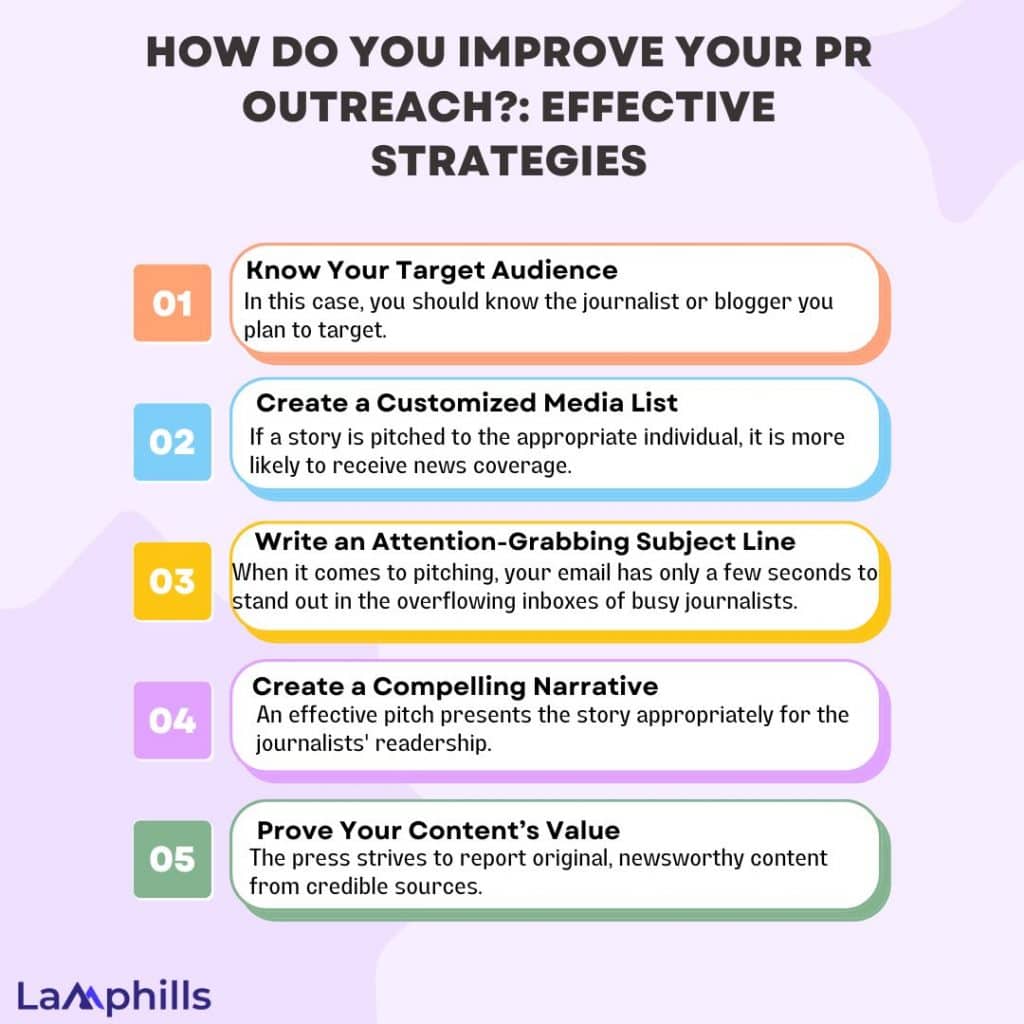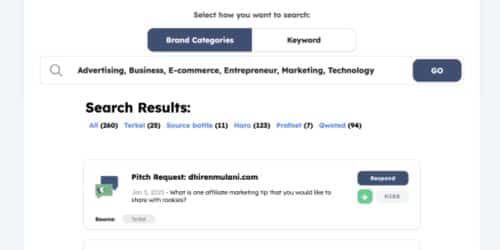When someone influential talks about your brand, it creates a ripple effect of awareness and interest that can improve brand affinity and guide more potential customers to your product or service. Whether it’s to get more eyes on your latest press release, build links to a new industry, or share your existing content, PR outreach is one of the best ways and strategies to make it happen.
If you can master the PR outreach process, you’ll have a repeatable and effective way of contacting decision-makers who can help you move the needle for your brand. In this article, I will show effective PR outreach strategies to help you push those products to your target audience.
Key Points:
- PR outreach (or media outreach) is a standard marketing process involving contacting relevant journalists, media outlets, influencers, bloggers, and other third parties to publicize all types of businesses, products, or services.
- The three main types of PR outreach include story pitches, press releases, and media alerts.
- Outreach and PR are marketing activities that involve pitching to people, following up, and promoting a company’s image, product, or service. However, they have different tones, targets, and processes.
- There are two main methods for PR outreach—email and direct/instant message.
What is PR Outreach?
PR outreach (or media outreach) is a standard marketing process involving contacting relevant journalists, media outlets, influencers, bloggers, and other third parties to publicize all types of businesses, products, or services. It is ideal for blanket coverage to help launch a new product, promote business stories that are in the local or national interest, or raise awareness of critical issues.
While PR outreach has roots in traditional print media, there are plenty of mixed media channels to target. But it all starts with contacting those relevant people mentioned above with your pitch, hoping they’ll choose to pick up your story and work with you to create content that will drive sales or traffic.
How Does PR Outreach Work?

Sometimes, you or your marketing or comms teams can handle much of your PR in-house. Keeping social media channels updated or covering employee relations can all be completed by the teams that know your products, services, and people best.
But, if you’re a more significant business, you may have regular campaigns or publicity needs. If so, you may already be using, or looking to use, a specialist PR firm like Lamphills to look after your public-facing image. While you or specific team members will be the contact for quotes, comments, or information, Lamphills will do any online and offline PR outreach on your behalf.
They’ll already work alongside influencers, media, public and industry figures, and publications and will target the most suitable for you and your campaign to maximize your exposure. Of course, almost every campaign will be different, but many will have similar aspects. So what is PR outreach like for them, and what’s involved?
- Campaign & Strategy Planning: Working with you to set and finalize your online or offline requirements, plan your overall campaign, specify targets, and identify relevant publications, websites, or other outlets.
- PR Outreach: We’ll then select the most suitable outlets for your campaign and reach out to all the right people, pitching your story in the best way to promote your business.
- Content Creation: The right content, anything from press releases and pitch emails to speeches and news stories, is written and edited using your key message as a base.
- Actioning & Reporting: Once approved, your PR team will send online or print publication content and track your campaign metrics and stats to see how it’s performed.
Types of PR Outreach
Your first step is determining what information you want to share with your audience. This will help you choose the most effective way to contact your contacts. There are three main types of PR outreach.

#1. Story Pitches
A story pitch is when you suggest an idea for a feature story and share persuasive content to support its creation.
For example, client ABC has just hired a new software development lead. ABC has traditionally used third-party solutions but is now looking to build its software and potentially market it to external customers. Would you be interested in talking with them about this new direction, what it means to the company, and how it might change the marketplace?
Story pitches are significant PR outreach essential to gaining video game publicity.
#2. Press Releases
A press release is a formal document traditionally used to announce major company milestones. Press releases report new products, companies, and new hires. As such, they are one of the types of PR outreach best suited for news items of more permanence, especially milestones.
#3. Media Alerts
A media alert is less formal than a press release and is typically used to convey recent news or an update from a company or a product. It is a sort of “filler” material between major announcements.
For example, a video game press release may unveil a new game and its release on various platforms. Meanwhile, media alerts are used between those press releases to announce new features, distribute trailers, and remind the media of the game’s release date.
Methods for PR Outreach
Now that you’ve determined what type of PR outreach you need (press release, media alert, or pitch), you must decide how to distribute it. There are two main methods for PR outreach—email and direct/instant message.
Choosing a distribution channel is straightforward. Emails are best for press releases and media alerts, while you can send story pitches via email or direct messaging/instant messages.
Here’s what you should consider for each format.
#1. Email
Most PR teams send press releases, media alerts, and story pitches via email, which allows you to include plenty of information. When sending an email, consider the subject line and the body content.
I have provided a comprehensive PR outreach email template for easy work on how to write one. You can check it out below.
Lamphills PR Outreach Email Template
Content
The saying ‘keep it simple’ applies when emailing the media. Try to summarise everything in the introductory paragraph, and let the readers decide if that info is compelling enough for them to keep reading.
If you’re sending a press release via email, include a short introductory message summarising the key details of the full press release. That way, the recipient can quickly determine whether the topic interests them. It’s also good to include why you think this would affect them.
Media alerts are informal, so the corresponding email should be short and to the point. You don’t need an introductory paragraph; you can lead in with your content.
If you’re emailing a pitch, keep it to the point. Tell the reader what you’d like them to write a story about and why it’s worth their time.
#2. Direct Message
Direct messages are good when you need to ask a quick question, follow up on a pitch, or send some info via Discord, SMS/Text, WhatsApp, Twitter DMs, or another platform. Two important considerations when using DMs are permission and length.
Permission
First, ensure you have permission to message the recipient. Don’t look up an editor’s contact info and start DM’ing them. Be sure to check with them when you find their info to see if it’s ok to DM them short messages.
Length
Secondly, keep your direct messages short and pare them down brutally. DM’s are meant to be quick and to the point. Don’t send more than 1-2 sentences explaining what info you are offering. You don’t need to give paragraphs of background information, links to other stories, etc. Just directly say what you’re offering them.
Here’s an example of an effective DM:
Would you like to hear more about product ABC from creator XYZ, which we announced today? It’s like his other product, but it has several new features that I think you’d be interested in.
This direct message works because it is short and to the point. If you need more than 1-2 sentences to convey what you need to say, it is better to send an email.
How Do You Improve Your PR Outreach?: Effective Strategies

Now that you know what PR outreach is and why it is important, let’s figure out how to make it flawless.
#1. Know Your Target Audience
In this case, you should know the journalist or blogger you plan to target. Research media outlets (publications, magazines, blogs) and individual journalists you plan to contact. Read as many articles and blogs as possible written by those journalists about your subject. Check them out on social media.
This is crucial, as it will familiarize you with the type of content they produce and help you prepare content that interests you.
I can’t emphasize this enough:
Press outreach usually fails because the content pitched is not what the journalist writes about or is interested in. Before reaching out, ensure your story is a good fit for them. Also, engage in media monitoring.
This involves monitoring for terms related to your industry and your competitors.
It will help you find journalists and bloggers who write on those subjects. For example, if you’re a SaaS company owner, your PR outreach strategy would focus on terms related to your sector.
#2. Create a Customized Media List
If a story is pitched to the appropriate individual, it is more likely to receive news coverage. It will also support the growth of your reputation among influential and important journalists.
To make sure you have a media list that is both rock-solid and functional, follow these 5 steps:
Step 1: Define the content you’re pitching
You must be clear on what type of content you want to pitch. Is it an interview with an executive, a new product announcement, or original research?
A targeted outreach list cannot be built without knowing what your outreach will look like.
Step 2: Create original angles
After you have a product or service to sell, please list all the journalists who would be interested in telling their readers about it.
Then, construct various “angles” or lead points for your material to make it pertinent to these reporters and their readers.
This way, your content will be targeted and relevant when you make outreach.
Step 3: Decide the Timing
Is your pitch only relevant immediately, or do you have “evergreen” stories at your company?
Will your pitch still be newsworthy four to six months from now?
These are important questions as they determine which types of media outlets you will target for specific content.
Online and daily newspapers, TV, and radio have shorter turnaround times of a few hours to a day. So, if your product launch is next week, you should pitch it to them.
Long-lead publications like magazines work anywhere from three to six months in advance. Here, you can pitch an executive interview, where the information will have a longer shelf life
Step 4: Look Up Publications and Authors
If you’re using a database to build your list, start with a general search for publications that write about your niche.
Then, search each publication or blog for relevant writers on specific topics and keywords related to your vertical.
Next, do a contact search for your keyword or topic. This will reveal writers who write about your topic in more mass-awareness publications, not just industry-specific publications.
For example, a general search for travel magazines will give you results like Condé Nast Traveler.
An in-depth search in Condé Nast Traveler will give you the names of multiple travel writers.
Next, when you do a contact search for “travel,” it will give you the names of journalists who write about travel in other publications that may not have a specific travel focus, like Better Homes and Gardens and Men’s Health.
Though not in the travel space, these publications may be relevant to your target audience.
Step 5: Pay Attention to Accurate Designations
Various media outlets categorize writers and journalists differently, making selecting which people to include on your media list challenging.
Editor-in-chief, staff writer, reporter—these are broad titles for journalists who produce material pertinent to you.
Never make a pitch to the chief editor. Typically, they are in charge of an outlet’s operations, such as choosing content rather than producing it.
#3. Write an Attention-Grabbing Subject Line
When it comes to pitching, your email has only a few seconds to stand out in the overflowing inboxes of busy journalists.
This is where a killer subject line that incites curiosity can come in handy.
Here’s the deal:
A subject line that is short and sweet yet piques curiosity and is personalized can be the determining factor in whether or not your pitch is even opened, let alone read.
Since 57% of journalists receive between 50 and 500 pitches per week, it’s essential to take your subject line seriously and do some A/B testing.
#4. Create a Compelling Narrative
An effective pitch presents the story appropriately for the journalists’ readership. The outline must be between 200 and 300 words long, clear, and succinct.
Consider possible news headlines and your material’s main point to that particular readership. Please share the content’s noteworthy aspects and highlight its poignant lessons in a brief list of bullet points.
Ensure your pitch is scheduled before the press release’s public publication if you offer an exclusive.
#5. Prove Your Content’s Value
Why is this relevant?
The press strives to report original, newsworthy content from credible sources. Your pitch will not be effective if you fail to prove your content’s value to the journalist and their audience.
So, be sure you highlight how your content aligns with their priorities.
Your content is valuable if it exemplifies these three qualities:
- It is Credible: Journalists strive to cite content whose data is credible and authoritative, so include the data source on which your content is based.
- It is Newsworthy: Highlight the newsworthy elements of your content. These could be its timeliness to a trending topic or proximity to a local readership.
- It is Relevant: Point out how your content resonates with the publication’s audience. Show how it will either educate, entertain, or inspire the readers.
Once you have your media list and a valuable story to tell, it’s time to write your pitch.
Just remember:
Make your pitches short and sweet. Provide important details and all your contact information, and don’t send large attachments via email.
What Are the Biggest PR Outreach Mistakes?

This is the article’s most exciting section. We asked over 100 communications professionals about the biggest pitching mistakes, and they gave us various impassioned answers. These experts include publicists, writers, journalists, digital marketers, and company owners.
We were interested in discovering PR outreach’s most significant challenges. And oh, did we receive some strongly held views.
What, then, were the most significant mistakes? Here are the top 5 biggest PR outreach mistakes.
#1. Not Researching the Media Contact or Their Publications
Reporters often tell me that one of PR’s biggest mistakes is sending a pitch to the wrong reporter. PR people must research to determine the right reporter(s). Is there quite a fit for your pitch? If it’s local/regional news, does the reporter cover that city or region?
Another related mistake is not researching and sending a pitch to multiple reporters simultaneously. This is spam and should never be done, although media databases are set up to allow it. ~ Michelle Garrett, Writer/Public Relations Consultant, Garrett Public Relations
The biggest mistake we found when speaking with communications folks is not researching who they’re talking to when contacting the media. 65 of the 100 participants, or 32.5%, said this is people’s most common pitching mistake.
This was the biggest gripe because it speaks to the culture of careless, obnoxious, mass-spamming tactics. To put it nicely, not researching the journalist or publication is a huge, annoying waste of time, and nobody likes it.
To avoid this, do your research. Take the extra time to contact the right person with their name spelled properly at the right email address. Everyone wins! And it’s the biggest, most sure-fire way to differentiate yourself from the competition.
#2. Not Providing Value
The biggest mistake I see PR people make is that they pitch products, not stories. Many frame their pitches with the mindset that journalists work for them and their clients. They focus too much on the product they’re trying to promote and not enough on its relevance to a specific audience. Journalists aim to inform, educate, and entertain their readers. That purpose shapes the way they pursue and present their stories. Your pitches will be successful when you approach them with that exact purpose. The writer will see that you care about their audience and how your topic would resonate. Instead of being a nuisance, you’re a source they can rely on for helpful content. ~ Corina Leslie, PR Manager, ZeroBounce
50 participants, or 25% of all respondents, indicated that not providing value was a common PR pitching mistake. Of course, your brand wants to be in the news—everyone’s brand wants to be in the news. But does that mean your story is newsworthy? Your pitch needs work if you can’t succinctly explain why your story interests the journalist’s audience within a sentence or two.
Plus, people are less likely to work with you if you don’t offer value. We all have that “friend” who only calls when he needs a ride to the airport or help moving his big couch but is radio silent when it’s time to return the favor. Sending out a PR pitch that only addresses your needs and never theirs makes you the communications equivalent of a pariah.
Learning to pitch our news as a story is in our best interests.
#3. Generic Pitching
Personalization has never been more important in PR pitching and communication with writers/reporters/editors. The biggest ‘hack’ isn’t a hack but just turns the clock back to when communication was more personal and directed than it is today. Generic email blasts, email newsletters, and using tools like Mailchimp to send to 1000 reporters at once aren’t going to work.
Instead, be more picky with your targets and take the time to put together a personal email chain with them. Personalize your first pitch to them and do the same with follow-ups each week to try and gently nudge them with the story idea you have in mind. If you are correct in your targeting, have an actual PR story to tell, and are persistent in your personalizing strategy, you should at least get word back from your recipients and—possibly—have it turn into a good opportunity.~ Austin Walters, Operations Director, WSA – The Communications Agency
Similar to the problem of not researching your media contacts, sending out a generic, boring mass pitch to anyone and everyone is a good way to get chucked into the spam folder. 21% of participants indicated that impersonal pitches are a huge industry problem. You certainly don’t need to write a heartfelt poem for each contact, but some individualization and personalization will go a long way.
Individualize your pitches. Discuss how the journalists’ previous body of work compliments the story you want to tell in some tangible way. Get as invested in them as you want them to be in you.
#4. Too Self-Promotional
One of the most common (and consistently made) errors in the PR world is people crafting press releases that have no actual worth – So many times, PR agencies are placed under pressure by clients to send out a press release that touches upon all their key points and strategies; the problem is the result is often overtly promotional and is of no use to any decent journalist. Your pitch must always be relevant, noteworthy, and newsworthy; otherwise, it will not get covered. When drafting a release, I always ask myself, ‘Would I write/read a story on this?’ to ensure I never lose sight of the end goal.~ JJ Lee, Digital PR Exec, Digital Funnel
Earned media is about having a story to tell. 12% of our comms respondents indicated that too many PR pitches are far too self-promotional. They don’t sell the story and only focus on the product or brand.
When pitching the media, keep the reader in mind.
#5. Pitches Are Way Too Long
Don’t make your pitch too long or too complicated. Keep it simple and concise—you don’t want to confuse or lose your prospect’s interest.~ Stephen Heffernan, Digital Marketing Specialist, The Connected Narrative
19 of our communications professionals (9.5% for those doing the math) indicated that media pitches are often too long. It’s tempting to want to tell your brand’s complete story and not leave anything out, but you risk losing the attention and focus of your already too-busy media contact.
Keep your pitch short, sweet, and to the point. Include all necessary links to assets, but make sure to clog up your pitch with manageable image or video files.
Do you know what’s significant to prevent this? An aesthetic press kit complete with your highest-quality images and multimedia.
How Is Outreach Different From PR?
Outreach aims to build links that power your website by targeting industry-specific websites. This involves gathering links on sites targeted to your brand’s niche, such as blogs, councils, tourist boards, or universities.
Although these sites don’t always have high domain authorities (DAs), they will be relevant to your brand, making them a decisive element in supporting your organic strategy.
On the other hand, PR seeks opportunities for your brand to gain exposure. Obtaining links through this tactic centers around relevant media news outlets and higher domain authority sites. Examples could include The Guardian, The Daily Mail, and The Telegraph.
Due to these sites’ high DA, driving links from them will lead to substantial SEO rewards, such as increased traffic and brand exposure, affecting your site’s ranking and DA overall. Joining wider conversations in the media, PR involves thinking creatively. This will help you generate ideas that publishers will want to link back to.
Best Tools to Use for Your PR Outreach Campaigns
The truth is that with all the available tools, it’s easy to get lost and overwhelmed by various choices.
I created this short list of three tools you’ll need to start your PR outreach efforts.
#1. LinkedIn

Everyone knows LinkedIn nowadays; most people use it for sales or content promotion/distribution.
The popular social media network currently has over 575 million users worldwide.
LinkedIn is one of the best ways to connect with journalists and bloggers before pitching them an idea or promoting one of your content pieces.
This is why Respona gives you the LinkedIn profile of the contacts you’re about to contact—so you can establish a relationship before sending a cold email pitch.
Feel free to check it out and be genuine with your interactions.
- Website: LinkedIn
- Why We Like It: It allows you to connect with anyone and interact with their content before pitching it to them.
- Pricing: Free/paid options available.
- Ideal For: Building relationships with journalists before sending them a pitch.
#2. Ahrefs

Ahrefs is an SEO competitor analysis software tool for businesses of all sizes.
It can be particularly useful when analyzing PR opportunities or trying to reverse engineer your competitors’ strategies for PR, link building, and content promotion.
Feel free to try it with a 7-day trial for $7 and see what Ahrefs can do for you.
- Website: Ahrefs
- Why We Like It: It helps you find out what websites promote your competitors and uncover opportunities for PR outreach.
- Pricing: Starts at $99 per month.
- Ideal For: Content research and competitor analysis.
#3. JustReachOut


JustReachOut is AI-powered PR software that helps you contact journalists, follow up automatically, and get new press coverage.
What features does it offer?
Journalist outreach includes AI pitch creation, automated follow-ups, a pitch request tool, a podcast, broken link building, and guest post outreach tools.
Who is it best for?
Generalist marketing agencies, in-house marketing teams, link-building freelancers, and agencies.
- Pricing: Starts at $98 per month
- Free trial: Available
- Pros: Easy to use, plenty of templates to start from
- Cons: Their USA database is better than the EU’s.
#4. Connectively (Previously Haro)

Previously known as HARO (Help A Reporter Out), Connectively is a platform that connects journalists and sources, letting them pitch one another with stories.
What features does it offer?
It allows journalists to ask for pitches for their upcoming stories so they can filter and choose the best responses. While sources can browse through daily queries and submit answers to the most relevant ones for a chance to get featured.
Who is it best for?
Journalists, freelancers, and subject matter experts who want to establish a brand’s presence or build links.
- Pricing: starts at $19 per month
- Free trial: there is a free plan that does not have email alerts included or the option of public profile viewing
- Pros: Their free plan, they have a good reputation and a large number of users
- Cons: It can feel like a hit or miss, no direct outreach is possible to specific targets
Bottom Line
In conclusion, PR outreach can be a great way to get positive exposure for your business. But it’s not as simple as sending emails and hoping for the best. To maximize your results, you need a thought-out and well-executed strategy.
By following the steps outlined in this guide, such as knowing your target audience, creating a customized media list, and writing an attention-grabbing subject line, you’ll be well on your way to generating results from your PR outreach campaigns.
Similar Articles
- PESO MODEL: Maximizing Your PR Strategy & Effectively Implementing The PESO Model
- PUBLIC RELATIONS SERVICES: The PR Blueprint for Getting Your Brand Noticed
- Top PR Firms In Nigeria In 2024






